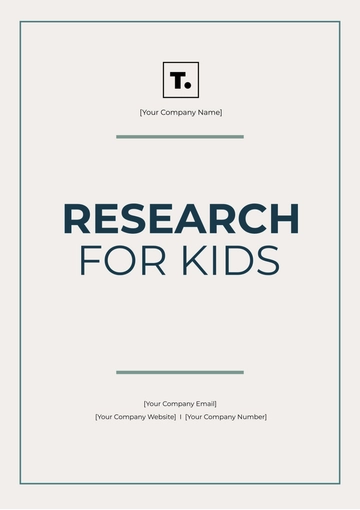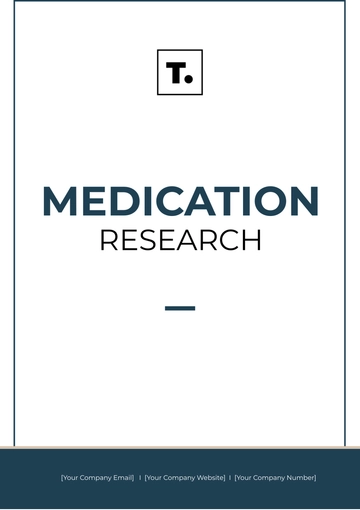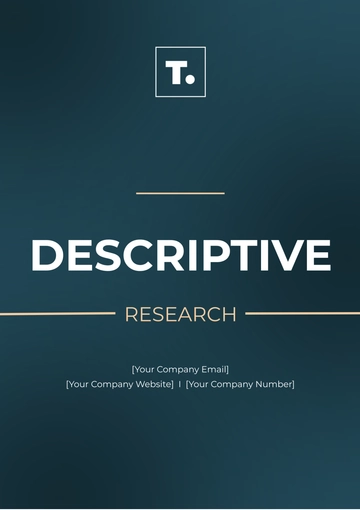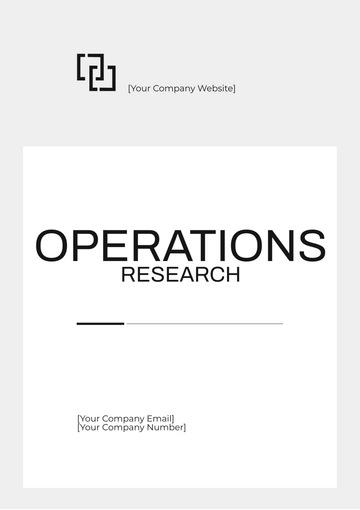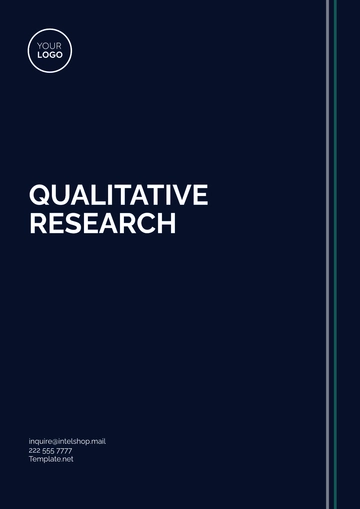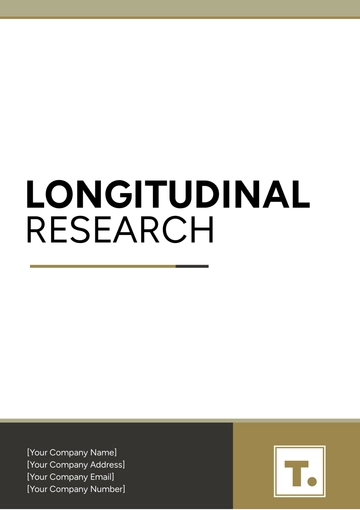Free Sales Client Feedback Integration Research

Executive Summary
The Sales Client Feedback Integration Research for [Your Company Name] represents a critical initiative aimed at harnessing the power of client feedback to transform and optimize the company's sales processes. This comprehensive research endeavor has been undertaken with the primary objectives of enhancing customer satisfaction, driving product improvements, and ultimately elevating sales and revenue performance. This executive summary provides a succinct overview of the key findings and recommendations from the research.
Client Feedback Integration Overview:
The research delves into the multifaceted process of integrating client feedback into [Your Company Name]'s sales operations. Recognizing that customer feedback serves as a valuable asset for strategic decision-making, the research examines various aspects of this integration, including data collection methods, feedback analysis, and strategies for seamless incorporation into the sales strategy.
Introduction
The Sales Client Feedback Integration Research for [Your Company Name] embarks on a journey to explore and enhance the integration of client feedback into the company's sales processes. As a dynamic player in the food industry, [Your Company Name] recognizes the paramount importance of aligning its sales strategy with the valuable insights offered by its diverse clientele. This introduction sets the stage for understanding the context and objectives of this research.
Company Background:
[Your Company Name], a well-established and reputable entity in the food industry, has been serving consumers with a delectable range of products for [number of years] years. Founded on a commitment to quality, innovation, and customer satisfaction, the company has carved a distinct niche for itself in a competitive marketplace.
With an extensive portfolio of products encompassing [mention product categories], [Your Company Name] has not only met but often exceeded customer expectations. However, in today's ever-evolving market landscape, the pursuit of excellence is unending. This necessitates an introspective exploration into ways to further enhance customer satisfaction, thereby solidifying the company's position as an industry leader.
Research Objectives:
The primary objectives of the Sales Client Feedback Integration Research are multifaceted, aiming to address critical facets of integrating client feedback into the sales processes:
Enhancing Customer Satisfaction: The central objective of this research is to understand how [Your Company Name] can leverage client feedback to elevate the overall satisfaction levels of its customers. By comprehending customer preferences, pain points, and expectations, the company can proactively tailor its offerings and services to align with customer needs.
Driving Product Improvements: Through rigorous analysis of client feedback, this research seeks to uncover actionable insights that can catalyze product development and innovation. By identifying recurring themes and areas for improvement, the company can refine its product offerings to remain at the forefront of the food industry.
Boosting Sales and Revenue: Effective client feedback integration is intrinsically linked to sales success. This research endeavors to explore strategies and approaches for seamlessly incorporating feedback into the sales strategy. By aligning sales tactics and product positioning with customer preferences, [Your Company Name] aims to bolster sales figures and drive revenue growth.
Competitive Advantage: In an industry characterized by rapid changes and fierce competition, obtaining a competitive edge is pivotal. This research will shed light on how integrating client feedback can provide [Your Company Name] with a distinctive advantage in the marketplace.
In summary, the Sales Client Feedback Integration Research represents a strategic undertaking for [Your Company Name], aligning with the company's commitment to continuous improvement and customer-centricity. Through a holistic examination of client feedback collection, analysis, and integration, this research aspires to chart a path towards enhanced customer satisfaction, innovation, revenue growth, and enduring competitiveness.
Methods
Effective data collection lies at the heart of the Sales Client Feedback Integration Research for [Your Company Name]. To capture the most comprehensive and meaningful client feedback, a range of methodologies and channels will be employed:
Surveys and Questionnaires: Structured surveys and questionnaires will be designed to gather specific information from clients. These will be distributed through various channels, including email, the company's website, and physical outlets, ensuring a diverse and representative sample of clients is reached.
Interviews with Clients: Qualitative insights will be acquired through in-depth interviews with select clients. These interviews will provide an opportunity to delve deeper into their experiences, opinions, and suggestions, offering valuable context to complement quantitative data.
Social Media Monitoring: In today's digitally connected world, social media platforms are hubs of customer feedback. Advanced monitoring tools will be utilized to track mentions, comments, and discussions related to [Your Company Name], providing real-time insights into customer sentiment.
Customer Support Channels: Feedback will be actively solicited through customer support channels such as call centers, email support, and chat. This will capture feedback at critical touchpoints in the customer journey, ensuring immediate responses to issues.
Customer Reviews and Feedback Forms: Online platforms, as well as physical locations, will be monitored for customer reviews and feedback forms. These sources often contain unfiltered, candid opinions and suggestions that can be valuable for analysis.
Incentivizing Feedback: To encourage more clients to provide feedback, the research will explore the use of incentives, such as discounts, loyalty points, or exclusive offers for feedback submission.
Data Analysis:
Once client feedback data has been collected, it will undergo a meticulous process of analysis to extract actionable insights and drive informed decision-making:
Quantitative Analysis: Data from surveys and questionnaires will undergo quantitative analysis. This includes calculating averages, percentages, and correlations to identify trends and patterns. Statistical software will be employed to manage and process large datasets efficiently.
Qualitative Analysis: Open-ended responses from surveys, interviews, and customer reviews will be subjected to qualitative analysis. This involves coding and categorizing comments to identify recurring themes, issues, and opportunities. Thematic analysis will help uncover nuanced insights.
Sentiment Analysis: To gauge overall customer sentiment, natural language processing (NLP) tools will be used to analyze text data from social media mentions, reviews, and feedback forms. Sentiment analysis will classify comments as positive, negative, or neutral, providing a sentiment score.
Benchmarking: To gain a competitive perspective, feedback data will be benchmarked against industry peers and competitors. This will reveal areas where [Your Company Name] excels and areas where improvements are needed.
Segmentation: Feedback data will be segmented by various criteria, such as product lines, geographic regions, or customer segments. This segmentation allows for more targeted analysis and customized action plans.
The comprehensive data collection and analysis process will form the foundation for the subsequent stages of the research, including the development of recommendations and strategies for integrating client feedback into [Your Company Name]'s sales processes effectively. The goal is to ensure that client feedback, whether positive or constructive, serves as a catalyst for continuous improvement and strategic decision-making within the organization.
Findings
In-depth exploration of client feedback integration within [Your Company Name]'s sales processes has yielded valuable insights across three key areas:
Client Feedback Collection:
Efficient and diversified methods for client feedback collection have emerged as follows:
Surveys and Questionnaires: The use of well-structured surveys and questionnaires has proven effective in gathering specific feedback from clients. Online distribution through the company's website and email campaigns has yielded a substantial volume of responses. Offering incentives for completing surveys has notably increased participation rates.
Interviews with Clients: In-depth interviews with select clients have provided rich qualitative data. These interviews have proven instrumental in understanding nuanced customer experiences, preferences, and pain points, especially in complex B2B relationships.
Social Media Monitoring: The deployment of advanced social media monitoring tools has enabled real-time tracking of customer sentiment, comments, and discussions. This has led to immediate insights into emerging issues and trends, allowing the company to respond promptly.
Customer Support Channels: Actively soliciting feedback through customer support channels, such as call centers and online chats, has resulted in a consistent stream of feedback. This approach ensures that feedback is captured at critical touchpoints during the customer journey.
Customer Reviews and Feedback Forms: Monitoring online platforms and physical locations for customer reviews and feedback forms has revealed unfiltered, candid opinions and suggestions. The wealth of data from these sources has been invaluable.
Feedback Analysis:
The analysis of client feedback has unveiled essential insights and trends:
Quantitative Analysis: Quantitative analysis of survey data has highlighted several trends and correlations. For instance, it has been noted that clients in certain geographic regions have consistently higher satisfaction scores. This information aids in targeted marketing and service improvements.
Qualitative Analysis: Qualitative analysis of open-ended responses has revealed recurring themes and issues. Common themes include suggestions for product enhancements, requests for improved customer service, and praise for specific aspects of the company's offerings. Thematic analysis has allowed for a deeper understanding of the client experience.
Sentiment Analysis: Sentiment analysis of text data from social media and reviews has provided a comprehensive overview of customer sentiment. The sentiment score indicates that the majority of client sentiment is positive, with specific mentions of favorite products and commendable customer service.
Benchmarking: Benchmarking feedback data against industry peers and competitors has uncovered areas of comparative advantage and potential weaknesses. This comparative analysis has informed strategic decisions and allowed for differentiation in the market.
Segmentation: Segmenting feedback data by product lines, geographic regions, and customer segments has been pivotal. It has highlighted variances in preferences and needs, enabling the company to tailor its strategies more effectively.
Recommendations
The insights gained from the Sales Client Feedback Integration Research have led to the formulation of strategic recommendations across three crucial dimensions:
Implement a Feedback Management System:
The integration of a feedback management system is instrumental in streamlining the collection, analysis, and utilization of client feedback:
Invest in Technology: [Your Company Name] is advised to invest in modern feedback management software and tools. These technologies will allow for efficient data collection, analysis, and reporting, reducing manual effort and improving data accuracy.
Integration with CRM: The implementation of a feedback management system should be integrated seamlessly with the company's Customer Relationship Management (CRM) system. This integration ensures that feedback data is automatically associated with customer profiles, enabling a holistic view of each customer's feedback history.
Real-time Data Access: The feedback management system should provide real-time access to feedback data, allowing sales teams to stay informed about the latest client sentiments and issues. This enables proactive response and engagement.
Develop a Feedback Action Plan:
To transform client feedback into actionable improvements, the creation of a comprehensive feedback action plan is imperative:
Standardized Process: Develop a standardized process for addressing feedback. This includes assigning responsibility for follow-up actions, setting timelines for resolution, and ensuring that feedback is categorized based on its nature and severity.
Prioritization: Establish criteria for prioritizing feedback items. Not all feedback will have the same level of impact on sales processes or customer satisfaction. Prioritizing based on significance and feasibility ensures that the most critical issues are addressed promptly.
Closed-Loop Feedback: Implement a closed-loop feedback system. Ensure that clients are informed about the actions taken in response to their feedback. This not only demonstrates the company's commitment to improvement but also fosters trust and loyalty.
Continuous Improvement: The feedback action plan should be dynamic and subject to regular review and adjustment. As new feedback is collected and trends emerge, the plan should adapt to address evolving customer needs and market dynamics.
Training and Education:
Ensuring that all stakeholders are equipped to participate in the feedback integration process is essential for its success:
Training for Sales Teams: Sales teams should receive training on soliciting feedback during customer interactions. They should be educated on the significance of client feedback in shaping sales strategies and improving customer relationships.
Company-Wide Education: Beyond sales teams, all employees should receive education on the importance of client feedback and how it aligns with the company's goals and values. An informed workforce is more likely to actively participate in feedback collection and implementation.
Feedback Champion: Appoint a feedback champion or coordinator within the organization. This individual is responsible for promoting a culture of feedback, disseminating best practices, and driving engagement with feedback initiatives.
Feedback Channels: Ensure that clients are aware of the available feedback channels and encourage their use. This can be achieved through clear communication, incentives, and ease of access to feedback mechanisms.
By investing in a feedback management system, developing a structured feedback action plan, and providing training and education to employees, [Your Company Name] can empower its workforce to actively contribute to the integration of client feedback into sales processes. These recommendations are pivotal in fostering a client-centric culture and driving continuous improvement, ultimately leading to increased customer satisfaction and sales growth.
Conclusion
The integration of client feedback into the sales processes of [Your Company Name] represents a transformative journey that holds the potential for significant and lasting benefits. As this research journey draws to a close, we reflect upon the profound impact that harnessing the power of client feedback can have on the company's future success and growth in the fiercely competitive food industry.
The comprehensive research undertaken in this endeavor has unveiled a wealth of insights and strategic recommendations. These findings underscore the vital importance of client feedback as a linchpin in the company's pursuit of excellence and customer-centricity.
A Roadmap to Success:
Through systematic client feedback integration, [Your Company Name] has charted a strategic roadmap that encompasses multiple dimensions:
Enhanced Customer Satisfaction: The findings highlight the company's commitment to elevating customer satisfaction levels. By actively listening to client voices, understanding their preferences, and addressing their concerns, [Your Company Name] is poised to build stronger and more enduring customer relationships.
Product Excellence: Feedback analysis has illuminated a path toward continuous product improvement and innovation. The ability to adapt and refine offerings based on client insights ensures that [Your Company Name] remains at the forefront of delivering products that resonate with the market.
Sales and Revenue Growth: The integration of client feedback directly contributes to boosting sales and revenue. Customizing sales strategies and product offerings according to client preferences not only enhances sales effectiveness but also fosters brand loyalty.
Competitive Advantage: By embracing a client-centric approach to sales processes, [Your Company Name] gains a distinct competitive edge. The ability to respond swiftly and effectively to client needs positions the company as a leader in the ever-evolving food industry landscape.
A Commitment to Excellence:
In conclusion, the Sales Client Feedback Integration Research for [Your Company Name] underscores the company's unwavering commitment to excellence and continuous improvement. By fostering a culture of feedback, investing in technology, implementing a feedback management system, developing structured feedback action plans, and providing training and education to its workforce, [Your Company Name] is poised to embark on a transformative journey toward excellence and profitability.
This research serves as a pivotal moment in [Your Company Name]'s evolution, where client feedback ceases to be just data points but becomes the driving force behind strategic decisions, product innovations, and customer-centricity. As the company embraces feedback integration as a core business practice, it is primed to thrive in a competitive landscape, setting new standards for customer satisfaction and success in the food industry. The future holds promise, and [Your Company Name] is well-prepared to seize it with open arms.
- 100% Customizable, free editor
- Access 1 Million+ Templates, photo’s & graphics
- Download or share as a template
- Click and replace photos, graphics, text, backgrounds
- Resize, crop, AI write & more
- Access advanced editor
Transform client feedback into actionable insights with Template.net's Sales Client Feedback Integration Research Template. Editable and customizable, this template facilitates the systematic analysis of feedback, empowering you to integrate responses effectively using our Ai Editor Tool for improved business outcomes.



